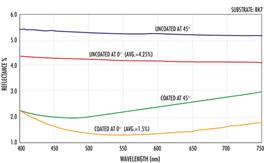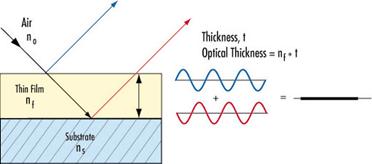• Anti-Reflection Coating
Core Optronics offers all transmissive optics with a variety of anti-reflection (AR) coating options that vastly improve the efficiency of the optic by increasing transmission, enhancing contrast, and eliminating ghost images. Most AR coatings are also very durable, with resistance to both physical and environmental damage. For these reasons, the vast majority of transmissive optics includes some form of anti-reflection coating. When specifying an AR coating to suit your specific application, you must first be fully aware of the full spectral range of your system. While an AR coating can significantly improve the performance of an optical system, using the coating at wavelengths outside the design wavelength range could potentially decrease the performance of the system.
COATING THEORY
- Why Choose an Anti-Reflection Coating?
As light passes through an uncoated glass substrate, approximately 4% will be reflected at each interface. This results in a total transmission of only 92% of the incident light. Applying an AR coating on each surface will increase the throughput of the system and reduce hazards caused by reflections traveling backwards through the system (ghost images). Anti-reflection coatings are especially important if the system contains many transmitting optical elements. Also, many low-light systems incorporate AR coated optics to allow for efficient use of light. Figure.1 demonstrates the difference between an uncoated and coated single surface BK7 substrate. The coating used is a 1/4 wave of MgF2 centered at 550nm.
- How Does an Anti-Reflection Coating Work?
The transmission properties of a coating are dependent upon the wavelength of light being used, the substrate's index of refraction, the index of refraction of the coating, the thickness of the coating, and the angle of the incident light.
The coating is designed so that the relative phase shift between the beam reflected at the upper and lower boundary of the thin film is 180°. Destructive interference between the two reflected beams occurs, canceling both beams before they exit the surface. The optical thickness of the coating must be an odd number of quarter wavelengths (λ/4, where λ is the design wavelength or wavelength being optimized for peak performance), in order to achieve the desired path difference of one half wavelength between the reflected beams, which leads to their cancellation.
The equation for determining the index of refraction of the thin film needed for complete cancellation of the two beams is:
nf=(n0ns)1/2
nf is the index of refraction of the thin film
n0 is the index of refraction of air (or the incident material)
ns is the index of refraction of the substrate

Fig.1: MgF2 Anti-Reflection Coating Performance

Fig.2: Illustration of Light Interacting with Thin Film
